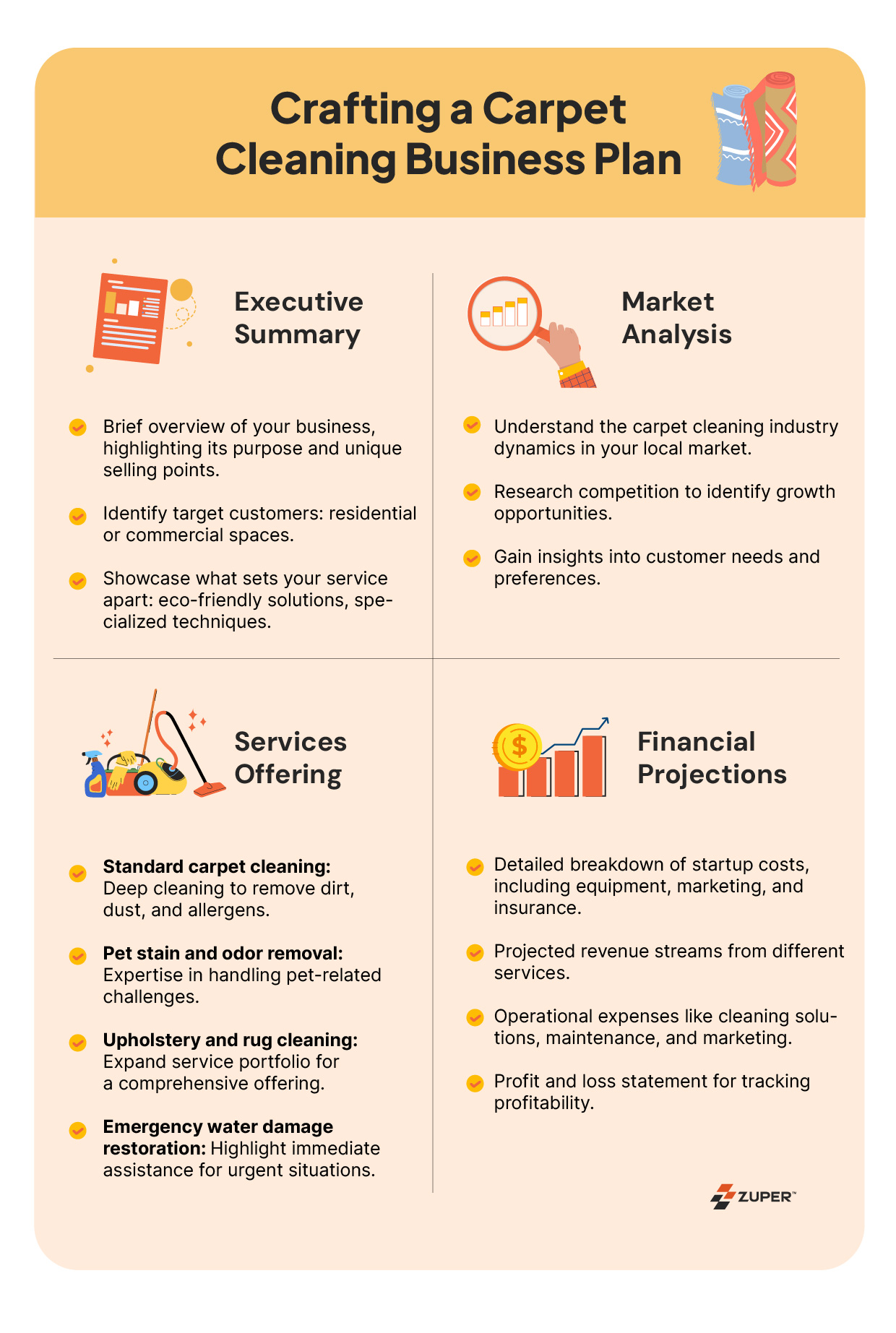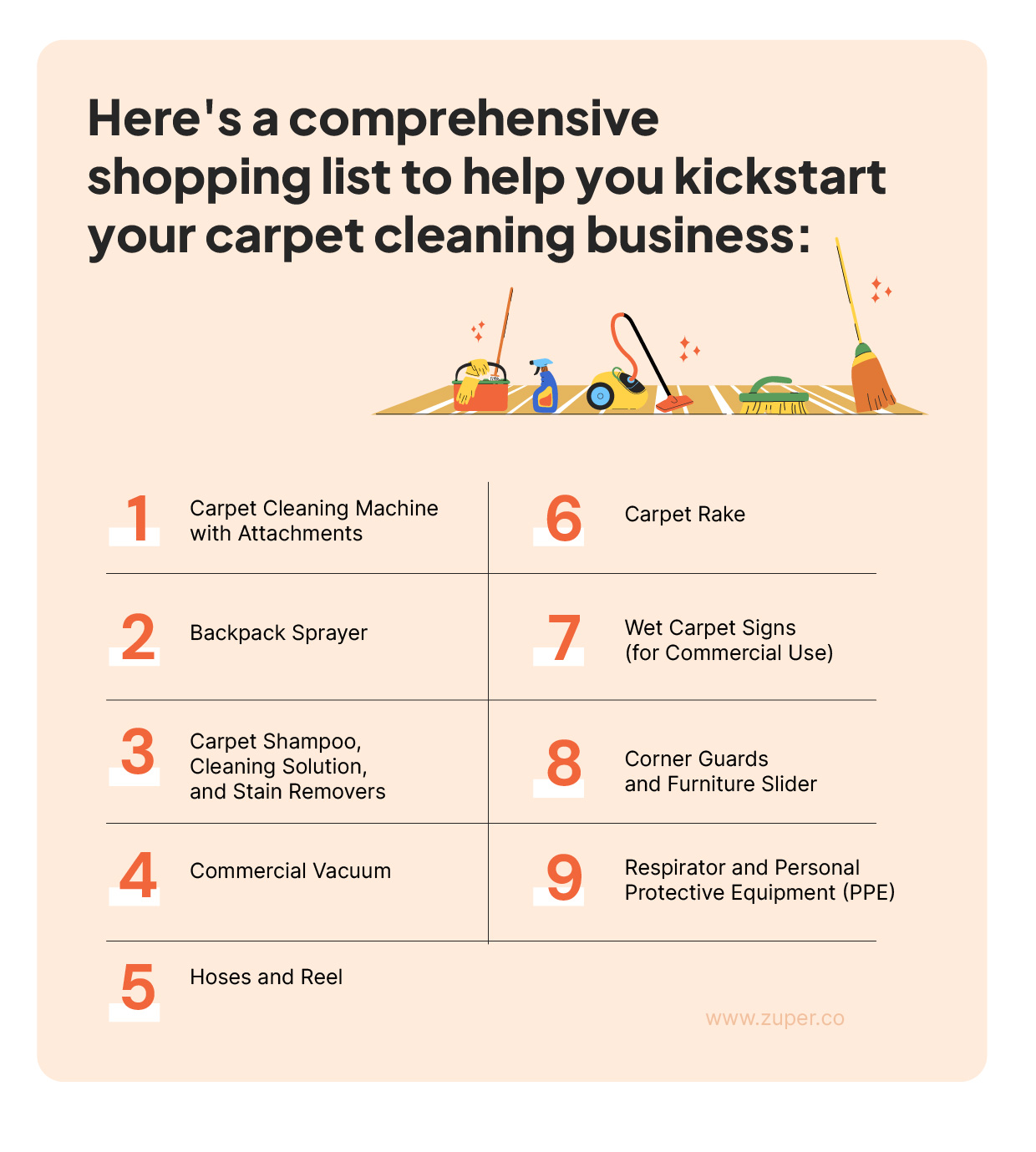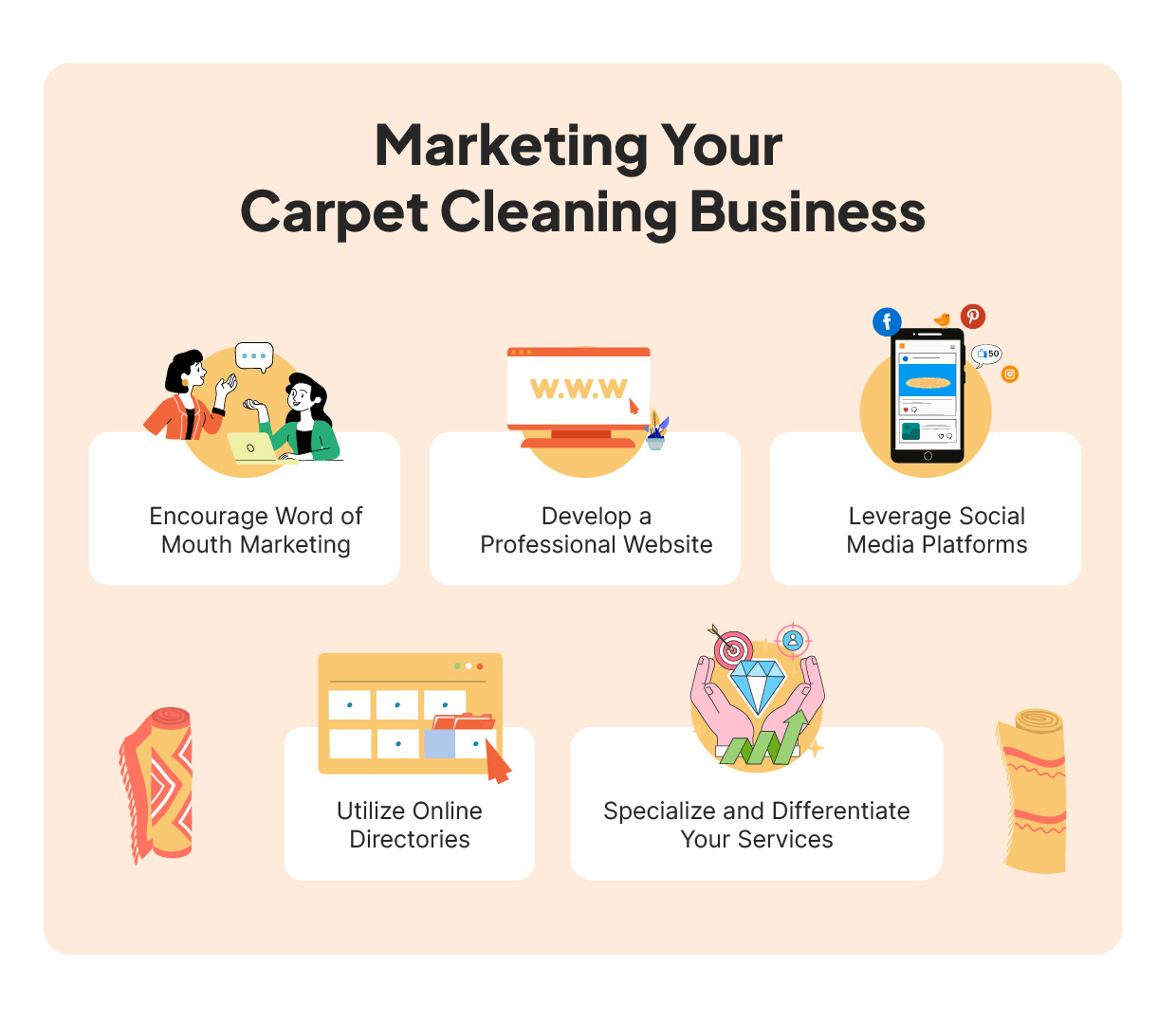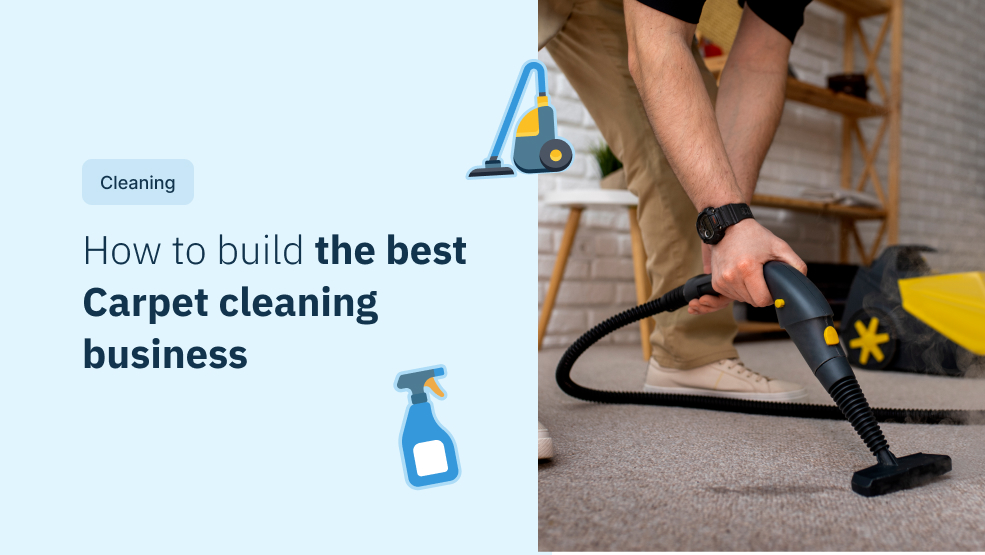Are you thinking of starting your own business? Among many options, the carpet cleaning industry presents a great opportunity. The demand for carpet cleaning services is increasing rapidly as people worldwide desire clean and hygienic living and working spaces. What makes it even more appealing is the impressive profitability of this industry.
The global market for carpet cleaners is projected to reach a massive $937.58 Million by 2027, with a steady growth rate of 6.28%. This reflects the ever-increasing demand for carpet cleaning services on a global level.
Why carpet cleaning? understanding the business’s potential
A carpet cleaning business is a service-based business that involves removing dirt, stains, allergens, and odors from carpets and rugs. What’s great about this business is that it’s always in demand. Everyone wants their homes and workplaces to look great and be germ-free, so they’re willing to pay for carpet cleaning services.
Before you get starry-eyed with visions of overflowing cash flow, there are a few things to consider. Starting any business requires planning, effort, and a healthy dose of hustle. But don’t worry. This guide will act as your roadmap, guiding you through the essential steps to build a thriving carpet cleaning business.
Step-by-step guide to building your carpet cleaning business
1. Crafting a Carpet Cleaning Business Plan
A well-crafted business plan is the foundation upon which your carpet cleaning business will be built. It serves as a roadmap, guiding you through the essential steps of starting and growing your venture. Think of it as a comprehensive document that attracts potential investors, secures funding, and keeps you focused on achieving your goals.
Here’s a detailed breakdown of the key elements you should incorporate into your carpet cleaning business plan:

1. Executive Summary
The executive summary is a snapshot of your business, providing a brief yet compelling overview for stakeholders and potential investors. Imagine you have only 30 seconds to persuade someone to invest in your business. The Executive Summary is your chance to do just that. This concise overview should capture the essence of your business, including:
- A brief explanation of your company’s purpose and core values. What makes your carpet cleaning service unique?
- Who are your ideal customers? Are you focusing on residential or commercial spaces?
- What sets you apart from the competition? Do you offer eco-friendly cleaning solutions or specialized stain removal techniques?
2. Market Analysis
Conducting a thorough market analysis is crucial to understanding the dynamics of the carpet cleaning industry and identifying lucrative growth opportunities. Before diving headfirst into operations, you must understand the carpet cleaning industry in your specific area. Conducting thorough research on your local market will provide you with valuable information and a better understanding of your competition.
3. Services Offering
Your business plan should clearly outline the specific carpet cleaning services you’ll provide.
Here are some examples to consider:
Standard carpet cleaning: This is the bread and butter of most carpet cleaning businesses, encompassing deep cleaning to remove dirt, dust, and allergens.
Pet stain and odor removal: Many households have furry companions, and pet accidents can leave behind stubborn stains and unpleasant odors. Highlighting your expertise in pet stain removal can attract a significant customer base.
Upholstery cleaning: Expand your service offerings to include professional sofas, chairs, and other upholstered furniture cleaning.
Rug cleaning: Offer specialized cleaning services for delicate area rugs and oriental carpets.
Emergency water damage restoration: Consider offering complimentary water damage restoration services, catering to situations where carpets require immediate attention.
4. Financial Projections
The financial section of your business plan serves two key purposes:
Securing Funding: If you require loans or investments to launch your business, a well-defined financial plan demonstrates your understanding of startup costs, potential revenue streams, and projected profitability.
Guiding Your Growth: Financial projections help you track your progress against set goals and identify areas where you might need to adjust your pricing or marketing strategies.
Key components of your financial projections should include:
Startup Costs: Outline the initial expenses required to launch your business, such as equipment purchases, marketing costs, insurance, and vehicle expenses.
Revenue Streams: Forecast your projected income from your various carpet cleaning services. Consider factors like pricing models, service packages, and customer frequency to estimate realistic revenue generation.
Operational Expenses: Detail your ongoing business costs, such as cleaning solutions, maintenance of equipment, vehicle fuel, employee salaries (if applicable), and marketing expenses.
Profit and Loss Statement: Project your profitability by subtracting your operational expenses from your projected revenue streams. This will give you an idea of your net profit or loss for each period.
2. Training and Certification
Although formal training is not always necessary, professional education can significantly enhance your carpet cleaning skills and set you apart in the competitive market. Numerous reputable carpet cleaning institutes offer comprehensive courses that cover essential topics, such as advanced cleaning techniques, effective stain removal methods, and fiber identification.
One of the industry’s most recognized and respected organizations is the Institute of Inspection, Cleaning, and Restoration Certification (IICRC). Their certification programs, including Carpet Cleaning Technician, Rug Cleaning Technician, and Commercial Carpet Maintenance Technician, provide you with the expertise and credentials to offer high-quality cleaning services.
Consider both in-person and online courses accredited organizations offer when embarking on your training journey. This flexibility allows you to tailor your learning experience to your schedule and preferences while gaining industry experts’ valuable insights and practical skills.
In addition to formal training programs, equipment companies like Jon-Don and Rotovac also offer specialized training sessions tailored to new business owners entering the carpet cleaning industry. These sessions cover essential topics such as equipment operation, maintenance, and best practices for business management.
Pro tip: “Collaborate with local businesses like house cleaners or realtors to expand your reach and access new customer segments.”
3. Opening a Business Bank Account and Securing Funding
Starting a carpet cleaning business requires establishing a clear financial foundation by separating your personal and business finances. One essential step is to open a dedicated business bank account, which simplifies bookkeeping and helps you track your business income and expenses. This separation will prove invaluable during tax season, as it streamlines filing taxes and deducting business-related expenses.
Apart from setting up a business bank account, creating a reserve fund to cover at least 90 days’ worth of expenses is prudent. This financial buffer serves as a safety net and provides peace of mind in situations like unforeseen cash flow issues or unpaid invoices. By proactively setting aside funds for emergencies, you can safeguard your business’s financial stability and mitigate potential financial risks.
4. Choosing a Catchy and Memorable Business Name
When choosing a business name, several key considerations can help you make the right decision. Your business name should describe your services while evoking positive associations with your brand. Set yourself apart from your competitors by opting for a name that is easy to pronounce, memorable, and unique within your local market.
It’s crucial to conduct thorough research to ensure your chosen business name is available as a domain name and does not infringe on existing trademarks. This step is essential for establishing a strong online presence and protecting your brand identity in the digital sphere.
Explore examples of catchy and memorable carpet cleaning business names to inspire creativity and spark ideas. Consider incorporating elements that reflect the essence of your services, such as cleanliness, freshness, and professionalism. Once you’ve selected a name that resonates with your brand vision, complement it with a well-designed logo that visually represents your business identity.
5. Registering and licensing your business
Registering and licensing your carpet cleaning business is a crucial step to establish its legitimacy and ensure compliance with local regulations.
To begin, register your business with the appropriate authorities in your locality. The registration process varies depending on your location:
United States: Consider trademarking your business name and registering your domain name for online visibility.
Canada: Register and potentially trademark your business name, unless it’s the same as your personal name.
United Kingdom: Verify name availability, then proceed to register your business name and entity.
Australia: Register your business with the Business Registration Service, ASIC, or a private service provider. Skip this step if your business name matches your personal name.
To understand the specific registration requirements in your area, conduct a quick online search using the format “COUNTRY + business registration” or consult your local government’s business registration division for guidance.
During the registration process, you’ll need to select a suitable business structure that aligns with your goals and legal obligations. Consider the following options:
- Sole Proprietorship (U.S., CA) or Sole Trader (UK, AU): Ideal for solo business owners seeking simplicity and autonomy.
- Partnership (U.S., CA, UK), Joint Venture, or Co-operative (AU): Suitable for businesses with multiple owners or collaborators.
- Limited Liability Company (LLC) (U.S.), Corporation (CA), Limited Company or Limited Partnership (UK), or Company (AU): Offers personal asset protection and legal separation between business and owner(s).
If you have employees or business partners, obtaining an Employer Identification Number (EIN) is essential for tax purposes. Apply for an EIN early to ensure compliance with IRS regulations and avoid potential issues. Securing a carpet cleaning business license is vital for operating legally within your jurisdiction. Even if it’s not mandatory in your area, obtaining a license demonstrates professionalism and instills trust in potential clients.
Contact your local Chamber of Commerce or the Small Business Administration (SBA) to determine the specific licensing requirements for your business. They can provide guidance on the application process and advise on the type of license best suited to your operations.
6. Purchasing carpet cleaning equipment
Acquiring top-notch carpet cleaning equipment is paramount to delivering exceptional services in your new business venture.

Depending on your business model and service offerings, you may also require specialized equipment for additional services such as upholstery cleaning, curtain cleaning, green cleaning, or vehicle interior detailing. Evaluate your specific needs and budget accordingly to ensure you have the necessary tools to deliver comprehensive cleaning solutions to your clients.
While investing in quality equipment is essential for delivering professional results, you have flexibility in managing costs. Consider options such as leasing new equipment, purchasing used items, or renting equipment from local hardware stores to suit your budget constraints. As your business grows and generates revenue, you can gradually upgrade to higher-end equipment to enhance efficiency and productivity.
7. Business Insurance
As a carpet cleaning business owner, it’s crucial to protect your business against unforeseen liabilities and potential risks with the right insurance coverage. To help you navigate your options, here’s a breakdown of essential insurance types to consider:
General Liability Insurance
This insurance provides coverage for financial losses arising from property damage or bodily injury claims filed by clients. It protects your business from legal expenses and compensation costs associated with accidents or incidents that occur during carpet cleaning operations.
Commercial Property Insurance
This insurance protects your business premises, office space, and carpet cleaning equipment. In the event of damage or loss due to fire, theft, vandalism, or other covered insecurity. This policy ensures that your assets are adequately insured, allowing for timely repairs or replacements.
Business Income Insurance
This insurance, also known as business interruption insurance, helps cover lost income and ongoing expenses if your carpet cleaning business is temporarily unable to operate due to a covered incident or disaster. It provides financial support to help keep your business afloat during periods of downtime, allowing for continuity of operations and mitigating the impact of unexpected disruptions.
8. Marketing Your Carpet Cleaning Business
Marketing your carpet cleaning business effectively is essential for attracting new customers and building a loyal client base. Here are some proven marketing strategies to help you promote your services and increase visibility in your target market:
- Encourage Word-of-mouth Marketing: Harness the power of satisfied customers by implementing a referral program and actively soliciting online reviews. Positive word-of-mouth recommendations from happy clients can significantly boost your credibility and attract new business.
- Develop a Professional Website: Create a user-friendly website where potential customers can learn about your services, view before-and-after photos of cleaned carpets, and easily book appointments online. Your website serves as a digital storefront, providing valuable information and showcasing your expertise to prospective clients.

- Leverage Social Media Platforms: Establish a presence on popular social media platforms such as Facebook, Twitter, or Instagram to connect with your target audience and showcase your work. Share cleaning tips, transformational before-and-after photos, and special offers to engage with followers and cultivate a sense of community.
- Utilize Online Directories: List your carpet cleaning business on prominent online directories and lead generation sites like Google My Business, Yelp, and Bing Places. Optimizing your profiles with accurate information and compelling visuals can improve your visibility and attract potential customers searching for carpet cleaning services in your area.
- Implement Offline Marketing Tactics: Supplement your online efforts with offline marketing strategies to reach local prospects directly. Distribute carpet cleaning flyers, utilize postcard marketing, or leave door hangers in targeted neighborhoods to raise awareness and generate leads.
- Forge Strategic Partnerships: Collaborate with local businesses such as house cleaners or realtors to expand your reach and access new customer segments. Position carpet cleaning as a complementary service to deep cleaning packages or as a value-added offering for property listings, leveraging existing networks and referral channels.
“ Pro tip: Zuper, a leading field service management (FSM) software solution, can be your secret weapon for optimizing your carpet cleaning business. Learn how Zuper can empower you.”
- Specialize and Differentiate Your Services: Identify niche service offerings that set your carpet cleaning business apart from competitors. Whether it’s specializing in pet-related stains, specific carpet types, or area rug cleaning, promoting unique services can attract customers seeking specialized expertise and solutions.
As you implement these marketing strategies, keep in mind the cost considerations associated with each tactic. Allocate your marketing budget wisely, prioritizing channels that offer the greatest potential for return on investment (ROI) based on your target audience and business objectives. With a strategic approach and consistent effort, you can effectively promote your carpet cleaning business and achieve sustainable growth over time.
9. Running and Growing Your Carpet Cleaning Business
Building a successful carpet cleaning business is an ongoing process. Here are some key strategies to ensure smooth operations and continuous growth
- Invest in customer relationship management (FSM) software. Streamline scheduling, invoicing, and communication with your customers.
- Provide exceptional customer service. Exceed expectations by being reliable, responsive, and delivering high-quality cleaning.
- Encourage satisfied customers to leave positive reviews online, which can significantly boost your credibility and attract new clients.
- Expand your service offerings to include upholstery cleaning, rug cleaning, or even duct cleaning to cater to a wider range of customer needs.
- Continuously learn about new cleaning techniques, equipment, and eco-friendly products to maintain a competitive edge.
- As your business grows, you might need to expand your team to handle increased workload.
Wrapping up
Equipping you with a roadmap to navigate the carpet cleaning industry, this guide has empowered you to build a successful business. From crafting a business plan to implementing marketing strategies, you now possess the knowledge to turn your venture into a profitable one.
Remember, the key to success is providing exceptional service, staying informed, and innovating to meet your clients’ needs. With dedication and the valuable insights from this guide, you’re well on your way to transforming your carpet cleaning business into a flourishing enterprise. Start cleaning your way to a brighter future today!




